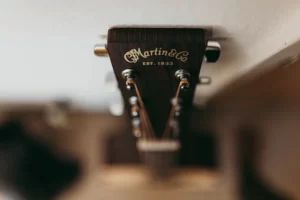Have you used an acoustic guitar but are unsure how to string it? This will be the site for knowledge on how to string an acoustic guitar. You will also learn how to remove the old strings and replace them. To get started, go through all the content below.
Changing Acoustic Guitar Strings: Step-by-Step Guide
Therefore, in guidance, we will define three procedures for switching or stringing an acoustic guitar, which involves maintaining the entire set of strings with a new batch. But before that, we need to learn when we might change it.
Check out our latest articles on restringing a classical guitar, how to hold a guitar pick, basics of acoustic and electric guitar for beginners, and many more.
When should I string my guitar?
Truthfully, there is no confusion on when to string an acoustic guitar. Thus, many informal guitarists change their strings every two or three months, so if you’re a serious player, you must change them more often.
Also, it varies depending on the tone you would like your strings to make. If you would like them to sound their most extraordinary for a soundcheck, you should substitute them after a few days. Acoustic guitar strings get a small opening in which they sound their utmost, so take advantage of it.
Supplies Required
I advise keeping the respective supplies on hand once stringing your guitar chords.
- A brand-new set of strings
- A pair of wire cutters
- Dunlop chassis and cleaning kit
- A winder of strings (or you can choose to use a 2-in-1 string winder and cutter tool)
When you’ve gathered your materials, it’s time to start stringing an acoustic guitar.
Stringing An Acoustic Guitar
Remove any existing strings
To set up strings, first, disconnect the original strings. This one is completed by the first harmonic distortion of each string till it is entirely weak, after which attempting to cut it in half. It is not necessary to cut the strings. However, it does consider its removal easier.
Detune the string since it no longer will have strain and no longer reflects a pitch. To trim the string in half, use pliers, ordinarily in which the neck reaches the body. Remove the old strings from optimal control posts and cross access afterward. Please do it again and again for each string.
Sweep the fingerboard after detaching
The ideal way to clean your guitar’s fingerboard and the fretboard is when all strings are removed instantly. Detach any stored debris with a clean cloth. Uncompleted fretboards (rosewood, ebony, and so on) involve an integrated (oil-based) timber moisturizer, whereas finally, completed fingerboards only necessitate a light polish.
Add new ones
Now let us add the new strings and that you’ve eliminated the old ones. Once replacing old strings, its most important fact to notice is not to over-tighten those. This is because the strings must extend and adapt to a new strain.
Just be aware that when the strings are tuned too strong (above standard tuning), they may freeze under strain. To avoid triggering new strings, replace them one at a time, keeping track of which one you’re substituting or which tuning pivotal adapts it.
Installing Strings Is Divided Into Three Steps:
Add Strings From Package Via Color Identification
To begin, aim to discover and add each string. Take the strings out of their wrappers. Determine the string’s identity using the tag or the coloring of its rolling end. Loosen the string and add that through the correlating tower entrance. Lift it cautiously across, using your fingers to keep it from crushing it against the bridge slot. Coincide the string for the over bridge seat and the nut slot.
The Non-Ball End Is Then Crimped And Trimmed
No delay before the bridge/tailpiece; instead, direct the string to the center point of its respective tuning thread. Based on the tuner look, keep moving the string to the tuning thread. Cut an added 1–2 inches of string from the optimal control thread with the wire cutters.
Evaluate 1–2 inches to where the string passes the tuning post and twist (a.k.a. crimp) the string at a 90-degree angle. Trim an extra half to an inch of string further than the crimp with wire cutters.
Finally, tighten the string and air it across the tuning post. At that point, detach any loose curls that have formed since assembling the string. Fasten the string by transitioning the optimization key and ensuring that the thread is tightly wrapped together with the thread.
Keep on going to turn the key and arrange the string so that it becomes unknotted and stable against an accurate bridge back and nut hole as the ball’s final part gets closer to the bridge/tailpiece. Keep turning the key until the ball ends flush with the bridge/tailpiece. Trim any extra string after tuning the string to throw the ball.
Stretch and fine-tune
After being restrung, you’ll recognize that now the strings will continue to do it out of harmony when they’ve “resolved” or “damaged in.” This is because they must adapt to the changing tension. One method for reducing the time required for said strings to adjust is to stretch the string. Spread the string across its total length to attune it faster and sustain the tone.
Repetition tuning, stretching, and stretching. I brought the string up to pitch with a tuner. Stretch the thread delicately across its length (the fretboard). Replicate the tuning and squeezing cycle there until the sound of each string has cleared up. You have finally converted the strings on your guitar!
After Changing Strings, Reassemble Your Electric Guitar
Electric guitars must be “arranged” to satisfy string variation. That indicates that when you modify the strings, you must also alter the guitar. String strain is determined by the radius (gauge), which also influences the truss pipe (neck strings), activity (string length), and inflection (string length).
While stringing with almost the same pair of strings, you don’t have to make many adjustments; however, it never harms to nearly double.
How to Increase the Longevity of Your Guitar Strings
Stringing an acoustic guitar may not be the most enjoyable activity. This costs lots of money, but I am confident you’d also be playing your guitar. As such, if you would like to improve the performance of your guitar strings, there are a few aspects you should do.
After each use, clean up your strings and tuning pegs – It will also improve your strings’ performance by preventing sludge and rust from acquiring. You could even simply be using a fabric or a diligent tool to accomplish this.
Clean your hands whenever you perform: It thus must go “hand in glove” (offense meant) with the previous tip. Washing your hands reduces the quantity of oil and grime that piles up on the strings and fingerboard of your guitar. As a result, your strings will last longer.
Purchase good quality strings
Some string companies produce more durable guitar strings. For instance, this string company makes a special covering around their thread to enhance their life. They claim that such a coating helps increase the existence of their strings by 3-5 instances, and I can confirm that all these perform last far longer than some other string manufacturers.
Preserve your instrument in a cover
Keeping your guitar in a specific instance and adequately humidification will better prevent it from environmental variables such as temperature, particles, etc.
Conclusion
You made it! Now that you know how to string your acoustic guitar, pat yourself on the back. It’s not as hard as it seems and with a little practice, you’ll be able to do it like a pro. In no time at all, you’ll be playing your favorite tunes and impressing all of your friends (or just sitting around in peace and quiet). If you run into any problems or have any questions, feel free to reach out to us – we love helping budding musicians get started. And who knows? Maybe one day you will be the one giving advice on how to string an acoustic guitar. Until then, happy strumming!
FAQs
Q: Is it possible to restring a guitar by yourself?
A: Yes, you can restring a guitar on your own. Tolerance, essential tools, and several minutes of practice are required. It’s not difficult to grasp how to string a guitar on your own and also save money.
Q: Which string should I place next to the guitar?
A: The sequence of the strings is not critical. So unless you need to use regular tuning, begin with the heaviest string and work down to the slimmest. You’ll find the following strings on a six-string guitar: From thickest to thinnest, EADGBE.
Q: Is it difficult to string a guitar?
A: Putting on a new string is more complex than it appears. If you’ve never performed it before, this will show up difficult. You will require the following equipment:
- A winder of strings (comes with most guitars)
- a pair of tongs or pliers
- a tiny crescent wrench (for older guitars)
Q: How about if you string the wrong guitar?
A: This will sound ridiculous if you string the wrong guitar. Lower-pitched strings are the deepest, while higher-pitched cords are the thinnest. Furthermore, the denser strings have much more strain on them if they’re under more pressure. The instrument will appear emotionless and dreary. The string would not oscillate correctly, resulting in a poor sound.







